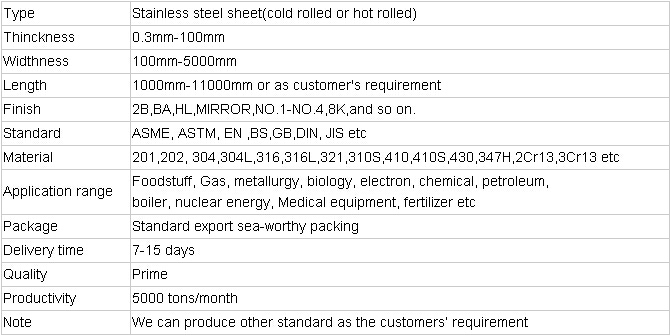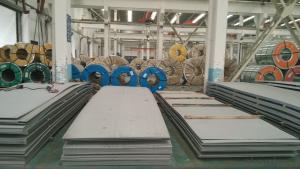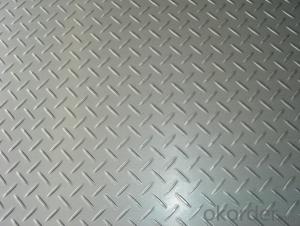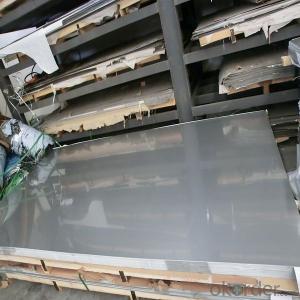Stainless Steel 304 sheet with reasonable pricing
- Loading Port:
- Shanghai
- Payment Terms:
- TT OR LC
- Min Order Qty:
- 1000 m.t
- Supply Capability:
- 1000000 m.t/month
OKorder Service Pledge
Quality Product, Order Online Tracking, Timely Delivery
OKorder Financial Service
Credit Rating, Credit Services, Credit Purchasing
You Might Also Like
Stainless steel 304 sheet
Company advantage of stainless steel:
-Top Equipments, Leading In The Industry.
- Professional Team, Leading Innovation.
- Huge Supply Capacity Advantage, Timely and Effective Delivery.
- Modern Logistic, Fact and Convenient.
- Precise Manufacturing, Exquisite Products.
- Serve People, Create Value.
- Dimensional Network, Powerful Expansion.
Product Information of stainless steel sheet:


- Q:What is the difference between 304LN and 304 stainless steel pipes?
- The main difference between 304LN and 304 stainless steel pipes lies in their chemical composition and mechanical properties. 304LN stainless steel is a nitrogen-strengthened version of 304 stainless steel. The addition of nitrogen improves its strength and resistance to corrosion, making it suitable for various applications in industries such as food processing, chemical processing, and pharmaceuticals. The nitrogen content in 304LN stainless steel is typically higher than that in standard 304 stainless steel, which enhances its overall performance. On the other hand, 304 stainless steel is a widely used austenitic stainless steel grade known for its excellent corrosion resistance, high-temperature strength, and ease of fabrication. It is commonly used in applications such as kitchen appliances, automotive parts, and architectural components. In terms of mechanical properties, 304LN stainless steel generally exhibits higher tensile and yield strength compared to 304 stainless steel. This makes it more suitable for applications that require increased strength or resistance to deformation. However, it is important to note that the specific mechanical properties may vary depending on the manufacturing process and heat treatment of the stainless steel pipes. In summary, the key difference between 304LN and 304 stainless steel pipes lies in their nitrogen content and resulting mechanical properties. While 304 stainless steel is a versatile and corrosion-resistant grade, 304LN stainless steel offers improved strength and corrosion resistance due to the addition of nitrogen. The choice between the two grades depends on the specific application requirements and the desired combination of properties.
- Q:How do you insulate stainless steel pipes?
- Insulating stainless steel pipes is a crucial step to prevent heat loss, condensation, and energy wastage. There are several methods to effectively insulate stainless steel pipes: 1. Pipe insulation wraps: This is the most common and cost-effective method. Pipe insulation wraps are available in various materials such as fiberglass, rubber, or foam. These wraps are easy to install and provide excellent insulation against heat transfer. They also act as a barrier to prevent condensation. 2. Insulation jackets: These are pre-formed covers made of insulation material like mineral wool or fiberglass. Insulation jackets are designed to fit around the stainless steel pipes and are secured with adhesive or straps. They provide a high level of thermal insulation and are ideal for pipes located in areas with extreme temperatures. 3. Spray foam insulation: This method involves spraying a layer of polyurethane foam insulation directly onto the stainless steel pipes. This creates a seamless and durable insulation layer that adheres well to the pipes, providing excellent thermal insulation and preventing moisture buildup. 4. Insulation tape: Insulation tape, typically made of foam or rubber, is wrapped around the stainless steel pipes to provide thermal insulation. This method is best suited for smaller pipes or areas where space is limited. Regardless of the method chosen, it is important to consider the temperature range, moisture exposure, and specific requirements of the stainless steel pipes when selecting insulation materials. Additionally, ensuring proper installation and maintenance of the insulation is essential to optimize its effectiveness and durability.
- Q:What are the dimensions and sizes of stainless steel pipes?
- The dimensions and sizes of stainless steel pipes can vary greatly depending on the specific application and industry requirements. Stainless steel pipes are available in various sizes, ranging from small diameter tubes of a few millimeters to larger pipes with diameters exceeding several feet. The dimensions of stainless steel pipes are typically specified by their outer diameter (OD), wall thickness, and length. The wall thickness can vary based on the intended use and pressure requirements of the pipe. Additionally, stainless steel pipes can be found in different shapes, such as round, square, or rectangular, to suit various installation needs.
- Q:How do you prevent pressure loss in stainless steel pipes?
- One way to prevent pressure loss in stainless steel pipes is to ensure proper installation and maintenance. This includes using high-quality fittings and connectors, following recommended guidelines for pipe sizing and support, and regularly inspecting and repairing any potential leaks or damages. Additionally, employing efficient flow control mechanisms such as valves and regulators can help minimize pressure loss in stainless steel pipes.
- Q:Can stainless steel pipes be used for pulp and paper industry applications?
- Yes, stainless steel pipes can be used for pulp and paper industry applications. Stainless steel is a highly durable and corrosion-resistant material, which makes it suitable for various industrial applications, including those in the pulp and paper industry. The industry involves the transportation of corrosive chemicals and liquids, such as acids, bleaching agents, and solvents, which can degrade and corrode regular pipes over time. Stainless steel pipes, on the other hand, are resistant to corrosion and can withstand the harsh chemicals and high temperatures commonly found in pulp and paper plants. Additionally, stainless steel pipes are also hygienic and easy to clean, making them suitable for applications where cleanliness is essential, such as food-grade paper production. Overall, stainless steel pipes are a reliable and long-lasting choice for the pulp and paper industry.
- Q:What are stainless steel pipes?
- Stainless steel pipes are pipes made from a corrosion-resistant alloy known as stainless steel. They are commonly used in various industries such as construction, oil and gas, and plumbing due to their durability, strength, and resistance to rust and corrosion. Stainless steel pipes are known for their long lifespan, high temperature resistance, and ability to withstand harsh environmental conditions.
- Q:How do you calculate the required support spacing for stainless steel pipes?
- To calculate the required support spacing for stainless steel pipes, several factors need to be taken into consideration. These factors include the pipe diameter, the material's weight, the temperature of the system, the fluid flowing through the pipe, and the desired safety factor. The first step is to determine the pipe diameter. This can be measured directly or calculated using the pipe's schedule and nominal size. Once the diameter is known, the weight of the stainless steel pipe per unit length can be determined using the density of stainless steel. Next, consider the temperature of the system in which the pipe will be operating. Stainless steel pipes can expand and contract with temperature changes, and this thermal expansion needs to be accounted for when determining support spacing. The thermal expansion coefficient of stainless steel can be used to calculate the expected expansion over the temperature range. The fluid flowing through the pipe should also be considered. If the fluid is corrosive or has high velocity or pressure, additional supports may be required to prevent excessive vibration or stress on the pipe. Lastly, the desired safety factor should be taken into account. This factor represents the additional support spacing required to ensure the integrity and stability of the pipe system. Common safety factors range from 1.5 to 3, depending on the specific application and industry standards. Once all these factors are known, various industry standards and guidelines can be used to calculate the required support spacing for stainless steel pipes. These standards provide formulas and tables that take into account the aforementioned factors, allowing engineers and designers to determine the appropriate distance between pipe supports. It is important to note that these calculations should be performed by qualified professionals with knowledge of industry standards and local regulations to ensure the safe and efficient operation of the stainless steel pipe system.
- Q:SA-179 what kind of material is steel pipe?
- Seamless steel pipe having a hollow cross section, used as a conduit for conveying fluids, such as pipelines for transporting petroleum, natural gas, gas, water, and certain solid materials.
- Q:What is the significance of the schedule in stainless steel pipes?
- The thickness of the pipe walls is what the schedule in stainless steel pipes refers to. It plays a crucial role in determining the pipe's strength, durability, and ability to handle pressure. The schedule is represented by a numerical value, such as Schedule 10, Schedule 40, or Schedule 80, which indicates the thickness of the pipe. The schedule's importance lies in its impact on the pipe's ability to withstand different conditions and applications. A higher schedule number means a thicker wall, resulting in increased strength and resistance to both internal and external pressures. This makes stainless steel pipes with a higher schedule suitable for applications that involve high pressure and high temperature, such as industrial processes, oil and gas pipelines, and chemical processing plants. Additionally, the schedule also affects the flow capacity of the pipe. Thicker-walled pipes have a smaller internal diameter, which reduces the flow rate compared to pipes with thinner walls. This factor is crucial when considering the fluid flow requirements in plumbing systems, HVAC installations, and other applications. The choice of the appropriate schedule for stainless steel pipes depends on specific project requirements, including pressure, temperature, and flow conditions. It is essential to select the correct schedule to ensure the pipe can safely and efficiently handle the intended application. To summarize, the significance of the schedule in stainless steel pipes lies in its influence on strength, pressure handling capabilities, and flow capacity. By understanding the schedule, engineers and professionals can make informed decisions when selecting and installing stainless steel pipes for various industrial, commercial, and residential applications.
- Q:What is the difference between seamless and seamless annealed stainless steel pipes?
- The difference between seamless and seamless annealed stainless steel pipes lies in the manufacturing process and the resulting properties. Seamless stainless steel pipes are made through a hot or cold rolling process, without any seams or welded joints. This results in a smooth and continuous pipe with high corrosion resistance and strength. On the other hand, seamless annealed stainless steel pipes undergo an additional annealing process after the seamless manufacturing. Annealing involves heating the pipe to a specific temperature and then slowly cooling it, which improves the material's ductility, toughness, and overall structure. This makes seamless annealed stainless steel pipes more suitable for applications requiring higher pressure or temperature resistance, as well as for processes involving bending or forming the pipe.
1. Manufacturer Overview |
|
|---|---|
| Location | |
| Year Established | |
| Annual Output Value | |
| Main Markets | |
| Company Certifications | |
2. Manufacturer Certificates |
|
|---|---|
| a) Certification Name | |
| Range | |
| Reference | |
| Validity Period | |
3. Manufacturer Capability |
|
|---|---|
| a)Trade Capacity | |
| Nearest Port | |
| Export Percentage | |
| No.of Employees in Trade Department | |
| Language Spoken: | |
| b)Factory Information | |
| Factory Size: | |
| No. of Production Lines | |
| Contract Manufacturing | |
| Product Price Range | |
Send your message to us
Stainless Steel 304 sheet with reasonable pricing
- Loading Port:
- Shanghai
- Payment Terms:
- TT OR LC
- Min Order Qty:
- 1000 m.t
- Supply Capability:
- 1000000 m.t/month
OKorder Service Pledge
Quality Product, Order Online Tracking, Timely Delivery
OKorder Financial Service
Credit Rating, Credit Services, Credit Purchasing
Similar products
New products
Hot products
Hot Searches
Related keywords






























